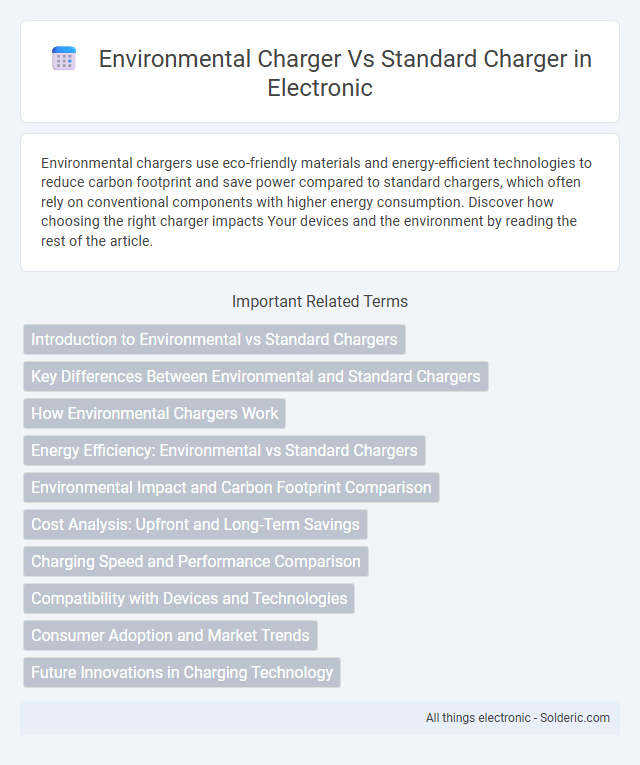Environmental chargers use eco-friendly materials and energy-efficient technologies to reduce carbon footprint and save power compared to standard chargers, which often rely on conventional components with higher energy consumption. Discover how choosing the right charger impacts Your devices and the environment by reading the rest of the article.
Comparison Table
| Feature | Environmental Charger | Standard Charger |
|---|---|---|
| Energy Source | Renewable (solar, wind, etc.) | Grid electricity (often non-renewable) |
| Carbon Footprint | Low to zero emissions | Higher emissions due to fossil fuels |
| Cost | Higher initial investment | Lower upfront cost |
| Operational Cost | Low, uses free renewable energy | Ongoing electricity expenses |
| Lifespan | Longer due to sustainable design | Standard lifespan |
| Charging Speed | Varies, often slower depending on energy source | Faster, consistent grid power |
| Environmental Impact | Minimal, supports sustainability | Higher, contributes to pollution |
| Usage | Ideal for eco-friendly users and off-grid | Common in urban and grid-connected areas |
Introduction to Environmental vs Standard Chargers
Environmental chargers use energy-efficient technology designed to reduce power consumption and minimize carbon footprint compared to standard chargers. Standard chargers typically prioritize charging speed and cost but often consume more electricity and generate greater environmental impact. You can contribute to sustainability by choosing an environmental charger that supports greener energy practices.
Key Differences Between Environmental and Standard Chargers
Environmental chargers prioritize energy efficiency and use eco-friendly materials, significantly reducing carbon footprints compared to standard chargers. Standard chargers typically operate with higher energy consumption and lack sustainable design features, leading to greater environmental impact. Environmental chargers often incorporate smart technology to optimize power delivery, enhancing battery life and minimizing electricity waste.
How Environmental Chargers Work
Environmental chargers harness renewable energy sources like solar or wind power to convert clean energy into electrical power, minimizing carbon emissions compared to standard chargers reliant on grid electricity. These chargers use photovoltaic cells or turbines to generate electricity, storing it in batteries or directly powering your devices, ensuring eco-friendly energy consumption. By choosing an environmental charger, you reduce your carbon footprint while maintaining efficient charging performance for your electronics.
Energy Efficiency: Environmental vs Standard Chargers
Environmental chargers demonstrate significantly higher energy efficiency compared to standard chargers, converting up to 90% of electrical input into usable power while standard chargers typically operate at 70-80% efficiency. Advanced technologies in environmental chargers reduce energy loss through heat dissipation, contributing to lower electricity consumption and reduced carbon footprints. This efficiency translates to faster charging times and cost savings, benefiting both users and the environment.
Environmental Impact and Carbon Footprint Comparison
Environmental chargers significantly reduce carbon footprints by utilizing renewable energy sources such as solar or wind power, resulting in lower greenhouse gas emissions compared to standard chargers that rely on electricity from fossil fuels. The manufacturing process of environmental chargers often incorporates sustainable materials and energy-efficient components, further minimizing environmental impact. Lifecycle assessments reveal that environmental chargers contribute to decreased pollution and resource depletion, making them a more eco-friendly alternative to conventional charging solutions.
Cost Analysis: Upfront and Long-Term Savings
Environmental chargers typically involve a higher upfront cost due to sustainable materials and energy-efficient technology, yet they offer substantial long-term savings by reducing electricity consumption and minimizing maintenance expenses. Standard chargers are generally less expensive initially but incur higher operational costs over time due to lower energy efficiency and shorter lifespans. Investing in environmental chargers results in a more cost-effective solution when factoring in energy savings, potential tax incentives, and reduced environmental impact over the device's lifetime.
Charging Speed and Performance Comparison
Environmental chargers often feature advanced technology such as smart energy management and optimized power delivery, resulting in charging speeds comparable to or faster than standard chargers. Your device benefits from improved performance stability and reduced heat generation, enhancing battery lifespan during fast charging cycles. Standard chargers may lack these efficiencies, potentially leading to slower charging times and increased energy waste.
Compatibility with Devices and Technologies
Environmental chargers are designed with advanced compatibility features supporting a wide range of devices, including smartphones, tablets, laptops, and electric vehicles, using universal charging standards such as USB-C Power Delivery and Qi wireless technology. Standard chargers often support only specific devices or proprietary connectors, limiting their usability across different brands and models. Environmental chargers emphasize energy efficiency and smart charging protocols, reducing device wear and optimizing battery health while maintaining broad technological compatibility.
Consumer Adoption and Market Trends
Consumer adoption of environmental chargers is rapidly increasing due to rising awareness of sustainability and government incentives promoting eco-friendly technology. Market trends indicate a surge in demand for chargers featuring energy-efficient designs, renewable material use, and smart charging capabilities that reduce carbon footprints. Standard chargers still dominate in volume but face declining growth as consumers and manufacturers shift toward greener alternatives driven by environmental regulations and evolving market preferences.
Future Innovations in Charging Technology
Future innovations in charging technology aim to enhance efficiency and sustainability, with environmental chargers leading the way by utilizing renewable energy sources such as solar or wind power. These chargers reduce carbon footprints and energy consumption compared to standard chargers that rely heavily on grid electricity derived from fossil fuels. Incorporating smart grid integration and advanced battery management systems, your charging experience will become more eco-friendly and cost-effective over time.
Environmental charger vs standard charger Infographic

 solderic.com
solderic.com